India
Goa
Goa remained a Portuguese overseas territory for 450 years until it was annexed by India in 1961.
There is a museum in town with very attentive staff of half a dozen or so who insisted, as we were the only customers, that we look at every exhibit.
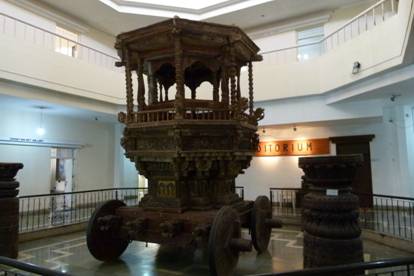
An elephant drawn coach
They had some Neolithic terracotta animals; and a mother and child dated at 2000 BCE. Fascinatingly these date back to the animism of the Indus valley, out of which the Hindu religion evolved.

In the museum we were interested to learn that Goa had been liberated after a long struggle by freedom fighters. These fighters for independence and liberation just happened to have strong affiliations with neighbouring India. Their heroic struggle resolved to inviting the Indian army in to expel the Portuguese. But somehow they didn't object when India simply annexed their country.
In the event, an Indian army of around 30 thousand troops, with air superiority and naval support, made short work of the previous administration that had just over 3 thousand defenders. 12 people died. Anyway the revolutionaries are all heroes to this day.
A monument to the heroism and sacrifice of the patriots was more recently erected in the middle of an intersection. Confusingly the date of the monument’s erection is prominently displayed; rather than that of the action it commemorates. So I wondered if there had been a second, little publicised, war of independence.
Unlike once Portuguese areas taken earlier by the Dutch and/or English and/or French, in Goa Christianity is definitely on the wane since 1961, with churches abandoned or seriously run-down.
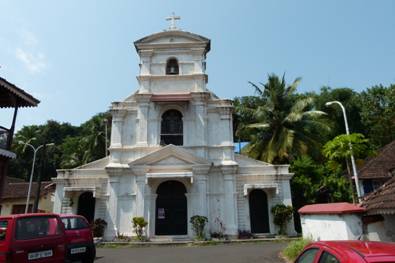
I guess that this is in reaction to all things Portuguese; like the Hungarian and Czech attitude to all things Russian.
Nevertheless the Portuguese administration did leave a legacy of one of the highest literacy rates in India.
For example when out walking we asked the guard on a gate where the steps marked on our map were and with little more than a glance he correctly pointed to the correct direction. The ability to read a map is extremely rare in India.
Almost everyone is literate in Goa. Our cab driver was indignant when we asked what proportion went to school – ‘everyone’, he said. ‘They must attend school from age 5 - 16 then longer if they want’.
Almost universal literacy has enabled Goa top become India's richest state with a GDP per capita two and a half times that of the country as a whole.
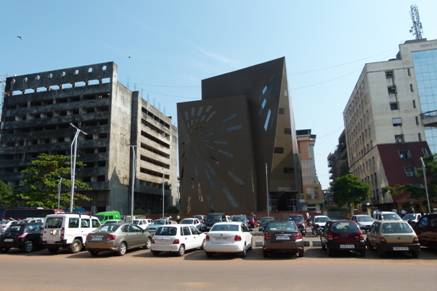
While we were in Goa there was a Court ordered moratorium on iron mining; and the barges that ship the ore lay inactive in the bay. This is Goa’s second largest industry, after tourism, but it has fallen foul of the Greens who accuse it of destroying the environment.
Goa is a very ‘hippy’ sort of place with a number of hemp wearing (and smoking) Europeans wandering about in a semi-dazed condition.
These are complimented by many young women and a few young men here for a good time on the beaches and for the relatively inexpensive lifestyle.
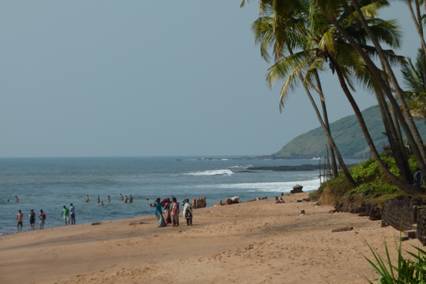
Greens abound in this their natural habitat.
But I had to admit this was a very good R&B group.
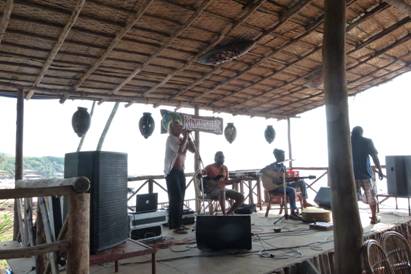
Like most of India the electricity fails, or is turned off for part of each day and diesel generators automatically kick-in; with around a second’s delay. This is not very green, but hey, you have to keep the mobile/cell/iPad charged; and the router powered-up.
More than once we had to remind ourselves that we were indeed in India. But there is something rather run-down about Goa. The rooms in our comfortable but rather shabby hotel have candles and next door is a 50 kW standby diesel generator. Power poles lean precariously across paddy fields.
One absence we notice is data cables festooning every post; yet the Internet works well and was free in our hotel.
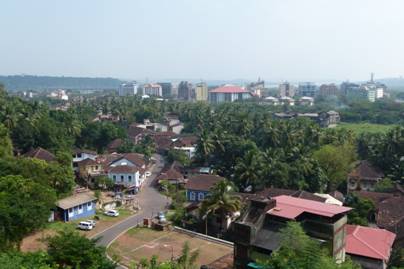
Do they have fibre optic cable to all businesses underground? There are lots of mobile phone towers, maybe that’s the answer?
We took a car down to old Goa where two massive Cathedrals stand, across the road from each other, belonging to competing Catholic orders. The white one (Sé Cathedral of Santa Catarina - 1640) is Franciscan and, since 1961 when Goa became part of India, the largest Christian church in India.
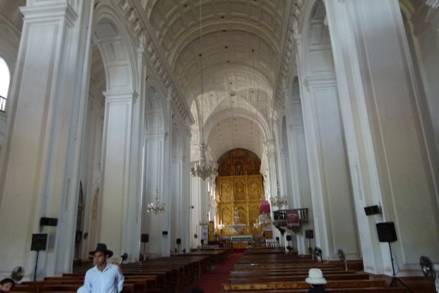
It is prettier than the older brown one (Basílica do Bom Jesus - 1605). This is Jesuit and houses most of the mortal remains of St Francis Xavier; except for some bits taken for use as relics in other churches.
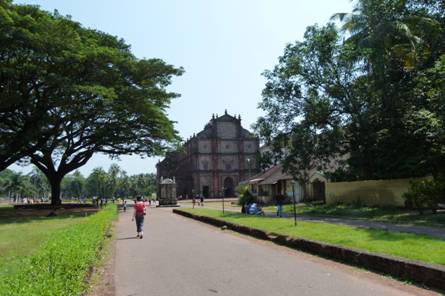
Except for these churches; and the associated Bishop’s Palace and convent, now a museum; little remains of old Goa. As a result there is no local congregation and neither is very active as a Christian church, although both are still consecrated and in use on special occasions.
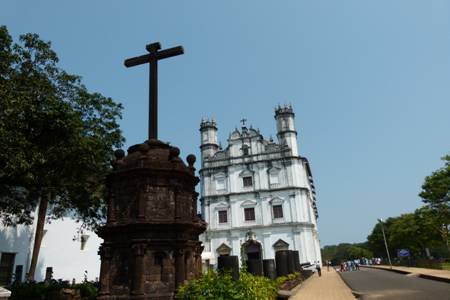
They are both protected Indian heritage on the Indian register of historical sights. They seem mainly to host large groups of predominantly Indian tourists and school children; who ignore the many signs requesting visitors to keep quiet; and maintain no decorum.
There is also the Church of the Our Lady of Immaculate Conception in Panjim, the main town; and nearby, on the hill, there is another Bishop’s Palace. The palace is a lot more commanding, and well preserved, than the church.
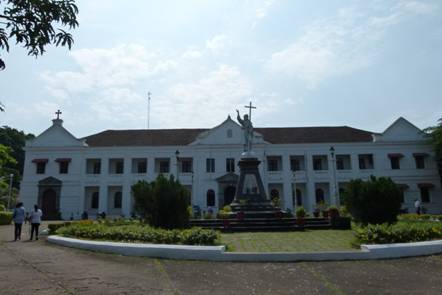
It is occupied by a flock of nuns and, presumably, a bishop. We noticed that they get through a fair bit of communion wine and were somewhat envious as wine is expensive in India.

A good deal of the surrounding hill is church land marked-off from the secular world by a boundary marked by numerous crosses on little pillars.
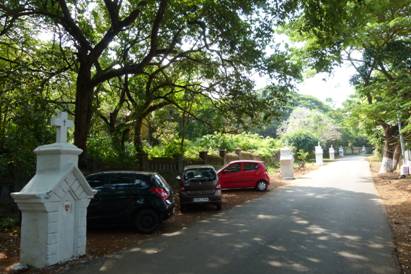
This land is probably valuable. The surrounding suburb is now the location of the largest and most impressive private dwellings in Goa; as well as a military training establishment. But the church land is overgrown and most of the buildings on it are abandoned and collapsing.
In the street below the Church in town is a Muslim primary school. This is notable for the female teacher and little girls in equal numbers sitting with little boys, just like a primary school anywhere. A lack of fundamentalism, and religious tolerance, is generally exemplary here.
Electricity
As we learnt on TV the other night, in a discussion about Indian/Australian relations, uranium is central to the relationship and the focus of our PM’s present visit.
India would like Australia to provide uranium oxide to fuel a planned massive expansion in electricity generation. A little over a quarter of the Indian population presently no has access to electricity; and Electricity is not available for 24 hours in most of the country.
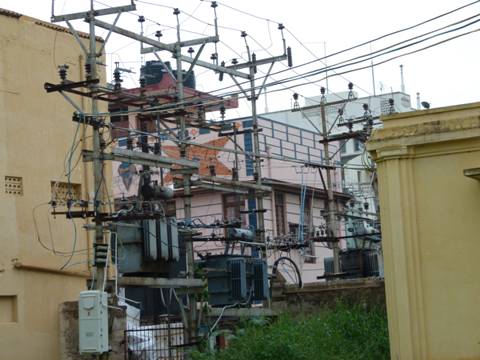
The country has unexploited coal and hydro-electricity resources. But the first is polluting, and has a high associated death toll, and the second is too limited to meet all the additional requirement and has environmental and land use issues.
India presently has 20 nuclear reactors (4.8 GW) that provide just 2.5% of India’s electricity. Seven larger, more advanced reactors are under construction (6.7 GW). Nine of its older reactors run on domestic uranium. Imports from France, Russia and Kazakhstan supply the remainder.
By 2050 India plans to generate 25% of its electricity in nuclear plants. The price and reliability of supply from existing sources is likely to be problematic in the context of the tenfold increase in fuel required. India needs assured supply security and for Australian mines with their very substantial resources, entirely for export, to be among the suppliers available to them.
But India is not a signatory to the Nuclear Non-proliferation Treaty. This is presently an Australian requirement for supply. Australia has accepted India’s 2005 IAEA-approved civil nuclear agreement with the United States as a precedent for negotiations to establish alternative safeguards.
The Indian commentators, on the TV panel, regarded it to be essential that India gets assess to the uranium - and even conceded the treatment of Indian students in Melbourne was a storm in a tea cup - that everyone should put behind them.
On a less enthusiastic note, apparently the Indian cricketer Sachin Tendulkar has been given an Order of Australia. This has been seen by some, naturally cynical, Indians as a blatant marketing gesture by Julia Gillard: ‘clearly intended to butter up customers for a big purchase’. They do think that we stupidly think that they are stupid.
